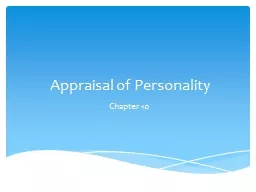

Chapter 10 Personality What is it How can it best be measured Personality assessment can Help identify client problems Help select interventions Assist in treatment decisions ID: 779326
Download The PPT/PDF document "Appraisal of Personality" is the property of its rightful owner. Permission is granted to download and print the materials on this web site for personal, non-commercial use only, and to display it on your personal computer provided you do not modify the materials and that you retain all copyright notices contained in the materials. By downloading content from our website, you accept the terms of this agreement.
Slide1
Appraisal of Personality
Chapter 10
Slide2Personality
What is it?
How can it best be measured?Personality assessment can:Help identify client problemsHelp select interventionsAssist in treatment decisionsAssist in structuring counseling relationship
Personality Assessment
Slide3Informal personality assessments:
Observation
InterviewingFormal personality assessments:Structured personality instrumentsProjective techniquesPersonality Assessment
Slide4Observation
:
Most commonly used method of informal assessmentCounselor subjectivitySelective recallSelective interpretationPre-existing assumptionsReliability & unsystematic error
Validity
– representativeness &
generalizability
Informal Assessment Techniques
Slide5Interviewing:
Diagnostic vs. descriptive
Consider quality of questionsReliability & validity concernsInformal Assessment Techniques
Slide6Methods of constructing personality inventories:
Content-related procedure
Personality theoryEmpirical criterion keyingFactor analysisInstruments most often used by counselors:Minnesota Multiphasic Personality Inventory 2 (MMPI-2)NEO PersonalityInventory-3 (NEO-PI-3)Myers-Briggs Type Indicator® (MBTI)
Structured Personality Inventories
Slide7Criterion-keyed
instrumen
t, used to diagnose emotional disordersNorming group of 2,600 selected to match 1980 census data, debate exists about racial bias567 items “true,” “false,” or “cannot say”Contains
validity
scal
es
, 3 types of clinical scales: Basic, Content, and
Special scales
MMPI-2
Slide8Validity scales:
Cannot Say (?)
True Response Inconsistency (TRIN)Variable Response Inconsistency (VRIN)Infrequency (F) - also Infrequency Back [F(B)] and Psychopathology Infrequency [F(p)]Symptom Validity (FBS)Lie (L)Correction (K)Superlative Self-Presentation (S)MMPI-2
Slide9Basic/Clinical
scales
: Hypochondriasis Depression Conversion Hysteria Psychopathic Deviate Masculinity-Femininity
Paranoia
Psychasthenia
Schizophrenia
Hypomania
Social Introversion
MMPI-2
Slide10MMPI-2
Slide11Based on different research than MMPI-2 – combination of factor-analytic methods and construct-oriented scale development
Contains 9
Restructured Clinical ScalesMMPI-2 Restructured Form (MMPI-2-RF)
Slide12MMPI-2-RF intended as an additional resource, not a substitute for MMPI-2
Clinicians require training, supervision and license to practice psychology in order to use MMPI-2 or MMPI-2-RF
Other MMPI-related instruments: California Psychological Inventory (CPI), Personality Inventory for Children - Second Edition (PIC-2)MMPI-2: Final Notes
Slide13Research suggests
indentified 5 major factors
of personality:I – Surgency (or Extroversion)II – AgreeablenessIII – ConscientiousnessIV – Emotional Stability or (Neuroticism)V – Intellect (or Openness to Experience)
Factors appear to apply across diverse
cultures
Abridged form: NEO Five Factor Inventory (NEO-FFI-3)
NEO-PI-3
Slide14Some debate over appropriate names for the 5 factors
Counselors should be aware of research on stability of personality across the lifespan
NEO-PI-3 useful for understanding clients, assisting in empathy and rapport building, providing feedback and insight, and selecting appropriate treatmentNot designed for assessing psychopathologyNEO-PI-3
Slide15Widely-used
B
ased on Jungian theoryFor individuals 14 years and olderTypology instrument providing scores on 4 dichotomies, resulting in individuals being categorized into one of 16 psychological typesMurphy-Meisgeir Type Indicator for Children (ages 7-12)MBTI®
Slide16Dichotomies:
Extroversion – Introversion
Sensing – IntuitionThinking – FeelingJudging – PerceivingPreferences on the 4 continuums result in a 4-letter code, producing a personality type
Most recent version: Form Q/Step II
each dichotomy further divided into five facets
Counselors need to be familiar with reliability and validity evidence for this instrument
MBTI
®
Slide17Sixteen Personality Factor Questionnaire
(16PF)
Includes measures of 16 factors and 5 global factorsVersion also exists for adolescentsJackson Personality Inventory – Revised (JPI-R)15 subscales organized into 5 higher-order clustersPsychometrically-sound and well-researchedOther Standardized Personality Instruments
Slide18Majority are self-report
instruments
Clients are able to distort results (“fake” good or bad)Risk of response setsTo increase validity of profiles:Inform client of purpose of inventory and how results will be usedInstruct client to answer each question honestlyAsk him/her to focus on each of the questions
Limitations of Standardized Personality Instruments
Slide19Provide client with
relatively
unstructured stimulus – examiner records and interprets responsesBased on psychoanalytic concept of projection – individuals’ tendency to project their drives, defenses, desires, and conflicts onto external situations/stimuliThought to uncover more of client’s unconscious and, thus, provide an indication of
covert
or latent
traits
More difficult to “fake” responses
Projective Techniques
Slide20Includes significant subjectivity in
interpretation
Extensive training needed to use them appropriatelyCategories:AssociationsConstructionCompletionsArrangement/selectionExpressionProjective Techniques
Slide21Association techniques:
Rorschach Inkblot
TestConstruction techniques:Thematic Apperception Test (TAT)Completion techniques:Rotter Incomplete Sentences Blank, 2nd ed.Rosenzweig Picture-Frustration Study
Projective
Techniques
Slide22Arrangement/Selection techniques:
Sandplay
Other techniques involving playExpression techniques:Drawing techniquesDraw-a-Person Test (D-A-P)House-Tree-Person (H-T-P)Kinetic Family Drawing (K-F-D)Projective Techniques
Slide23Strengths:
More difficult to fake
Can sometimes identify more complex themes and multidimensional aspects of personalityCan serve as an effective method of establishing rapportHelpful with children and nonverbal clientsLimitations:Low reliability evidenceMore caution needed when interpreting resultsMeager validation information
Lack of normative data
Can be dangerous with untrained users
Projective
Techniques
Slide24Debate and differing opinions on definition and characteristics of
self-concept
Most measures relate to individuals’ evaluations of their performance or feelings about themselvesSometimes used to obtain information on client attributes at beginning of counseling processUsed to examine effect of counseling interventionsSelf-Concept Measures
Slide25Examples
:
Piers-Harris Children Self-Concept Scale, Second EditionTennessee Self-Concept Scale – Second Edition (TSCS-2)Self-Concept Measures